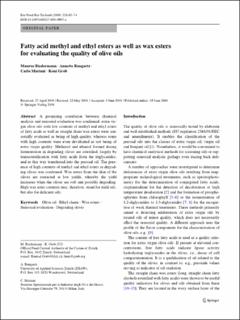Please use this identifier to cite or link to this item:
https://doi.org/10.21256/zhaw-1865Full metadata record
| DC Field | Value | Language |
|---|---|---|
| dc.contributor.author | Biedermann, Maurus | - |
| dc.contributor.author | Bongartz, Annette | - |
| dc.contributor.author | Mariani, Carlo | - |
| dc.contributor.author | Grob, Koni | - |
| dc.date.accessioned | 2018-03-26T14:32:24Z | - |
| dc.date.available | 2018-03-26T14:32:24Z | - |
| dc.date.issued | 2008 | - |
| dc.identifier.issn | 1438-2377 | de_CH |
| dc.identifier.issn | 1438-2385 | de_CH |
| dc.identifier.uri | https://digitalcollection.zhaw.ch/handle/11475/4261 | - |
| dc.description | Erworben im Rahmen der Schweizer Nationallizenzen (http://www.nationallizenzen.ch) | de_CH |
| dc.description.abstract | A promising correlation between chemical analysis and sensorial evaluation was confirmed: extra virgin olive oils with low contents of methyl and ethyl esters of fatty acids as well as straight chain wax esters were sensorially evaluated as being of high quality, whereas some with high contents were even devaluated as not being of extra virgin quality. Methanol and ethanol formed during fermentation in degrading olives are esterified, largely by transesterification with fatty acids from the triglycerides, and in this way transferred into the pressed oil. The presence of high contents of methyl and ethyl esters in degrading olives was confirmed. Wax esters from the skin of the olives are extracted at low yields, whereby the yield increases when the olives are soft and possibly degrading. High wax ester contents may, therefore, stand for mild oils, but also for deficient oils. | de_CH |
| dc.language.iso | en | de_CH |
| dc.publisher | Springer | de_CH |
| dc.relation.ispartof | European Food Research and Technology | de_CH |
| dc.rights | Licence according to publishing contract | de_CH |
| dc.subject | Olive oil | de_CH |
| dc.subject | Wax ester | de_CH |
| dc.subject | Ethyl oleate | de_CH |
| dc.subject.ddc | 664: Lebensmitteltechnologie | de_CH |
| dc.title | Fatty acid methyl and ethyl esters as well as wax esters for evaluating the quality of olive oils | de_CH |
| dc.type | Beitrag in wissenschaftlicher Zeitschrift | de_CH |
| dcterms.type | Text | de_CH |
| zhaw.departement | Life Sciences und Facility Management | de_CH |
| zhaw.organisationalunit | Institut für Lebensmittel- und Getränkeinnovation (ILGI) | de_CH |
| dc.identifier.doi | 10.21256/zhaw-1865 | - |
| dc.identifier.doi | 10.1007/s00217-008-0907-x | de_CH |
| zhaw.funding.eu | No | de_CH |
| zhaw.issue | 1 | de_CH |
| zhaw.originated.zhaw | Yes | de_CH |
| zhaw.pages.end | 74 | de_CH |
| zhaw.pages.start | 65 | de_CH |
| zhaw.publication.status | publishedVersion | de_CH |
| zhaw.volume | 228 | de_CH |
| zhaw.publication.review | Peer review (Publikation) | de_CH |
| zhaw.webfeed | Sensorik | de_CH |
| Appears in collections: | Publikationen Life Sciences und Facility Management | |
Files in This Item:
| File | Description | Size | Format | |
|---|---|---|---|---|
| 2008_Biedermann_acid_methyl_ethyl_esters_wax esters_quality_of_olive_oils.pdf | 624.17 kB | Adobe PDF |  View/Open |
Show simple item record
Biedermann, M., Bongartz, A., Mariani, C., & Grob, K. (2008). Fatty acid methyl and ethyl esters as well as wax esters for evaluating the quality of olive oils. European Food Research and Technology, 228(1), 65–74. https://doi.org/10.21256/zhaw-1865
Biedermann, M. et al. (2008) ‘Fatty acid methyl and ethyl esters as well as wax esters for evaluating the quality of olive oils’, European Food Research and Technology, 228(1), pp. 65–74. Available at: https://doi.org/10.21256/zhaw-1865.
M. Biedermann, A. Bongartz, C. Mariani, and K. Grob, “Fatty acid methyl and ethyl esters as well as wax esters for evaluating the quality of olive oils,” European Food Research and Technology, vol. 228, no. 1, pp. 65–74, 2008, doi: 10.21256/zhaw-1865.
BIEDERMANN, Maurus, Annette BONGARTZ, Carlo MARIANI und Koni GROB, 2008. Fatty acid methyl and ethyl esters as well as wax esters for evaluating the quality of olive oils. European Food Research and Technology. 2008. Bd. 228, Nr. 1, S. 65–74. DOI 10.21256/zhaw-1865
Biedermann, Maurus, Annette Bongartz, Carlo Mariani, and Koni Grob. 2008. “Fatty Acid Methyl and Ethyl Esters as Well as Wax Esters for Evaluating the Quality of Olive Oils.” European Food Research and Technology 228 (1): 65–74. https://doi.org/10.21256/zhaw-1865.
Biedermann, Maurus, et al. “Fatty Acid Methyl and Ethyl Esters as Well as Wax Esters for Evaluating the Quality of Olive Oils.” European Food Research and Technology, vol. 228, no. 1, 2008, pp. 65–74, https://doi.org/10.21256/zhaw-1865.
Items in DSpace are protected by copyright, with all rights reserved, unless otherwise indicated.